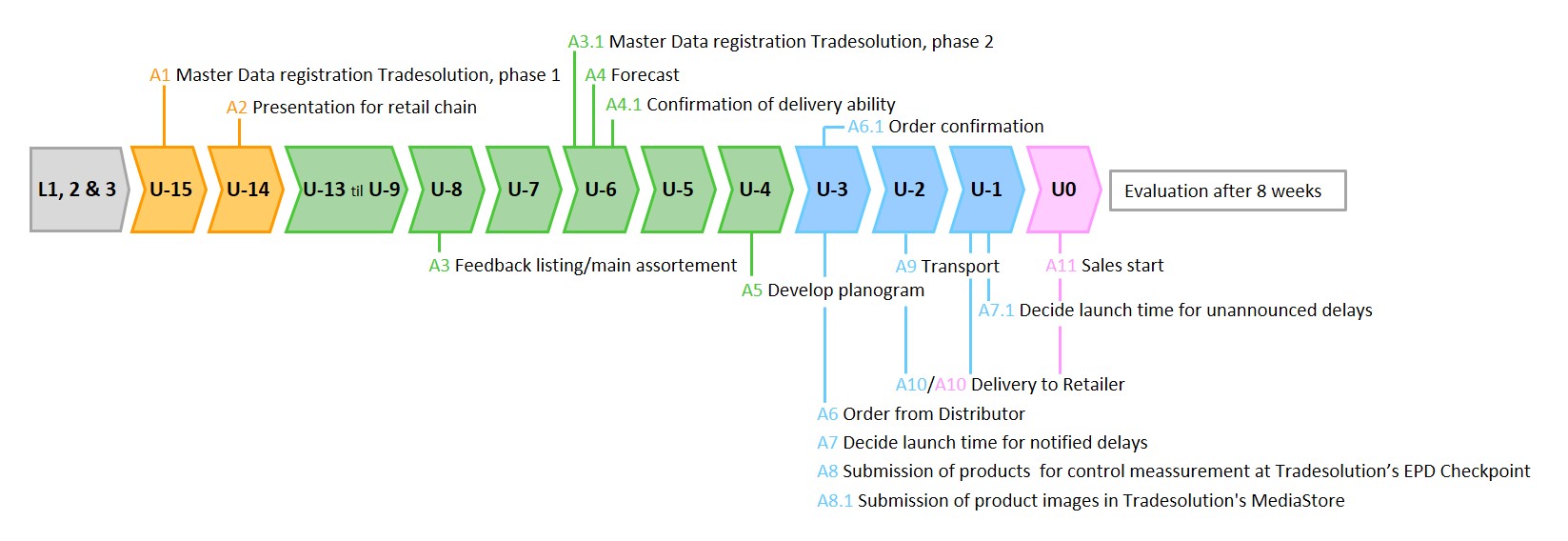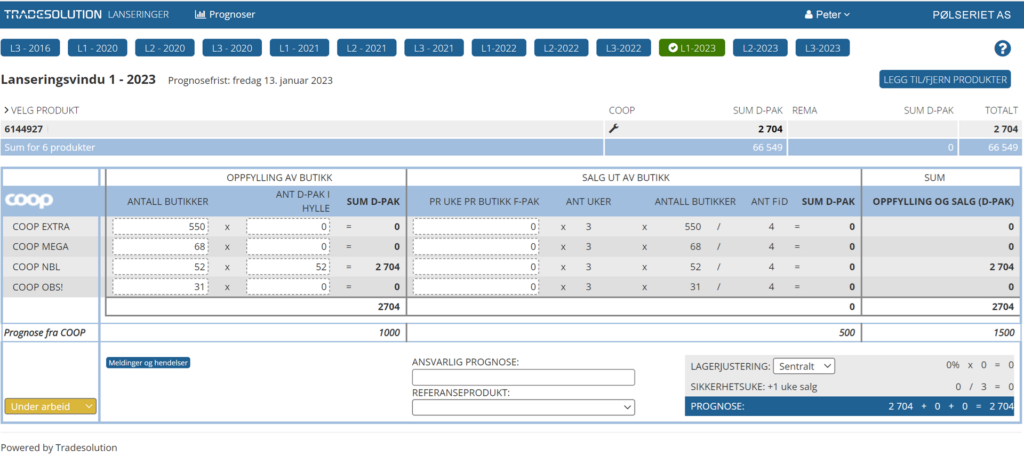Listing, all information attributes, forecast and delivery ability
Listing, all information attributes, forecast and delivery ability
This sub process consists of points (A3-A5 in timeline):
- Feedback on listing / main assortment and confirmation of delivery ability
- Time-managed or inventory-managed assortment change
- Master data registration – completion of complete information attributes
- Forecast and delivery confirmation (A4 in timeline)
- Routine for delay from supplier / private label
- Assortment changes outside agreed time frame

Feedback on listing / main assortment and confirmed ability of delivery (A3-A6 in timeline)
The feedback from the retail chain should include:
- Assortment classification per profile chain (new and old classification)
- Selected input and phase method (time-managed or inventory-managed)
- Included the list of products that are linked
- Products that are delisted
- The time of feedback about assortment is no later than U-8.
If the retail chain’s assortment selection of products leads to a supplier deciding to cancel or postpone launch, this should be reported to the relevant retail chain’s category manager by latest Friday at U-6.
For products being discontinued, any deviations from ordinary down sale must be clearly communicated in a reasonable time.
In case of product shortages at the supplier, the volume as confirmed in U-6 (A4 in timeline) is used as the basis of deviation handling ref.
Routine for delay from supplier / Private label
However, order confirmation of orders (A6) delivered no later than Tuesday in U-3 is to be considered as a binding agreement. Order confirmations will be given Wednesday U-3 (A6.1). Current deadlines are available in section for downloads.

Endringslogg
Time-managed or inventory-managed assortment change
Assortment change can be done inventory-managed or time-managed.
Inventory-managed assortment change means that outgoing products are sold until inventory is at a low level or sold out and then sales of the new product starts.
In the case of inventory-managed assortment change, new products will replace an outgoing item and / or take over its place in the shelf – link / product connection is used. Sales start will depend on inventory and sales on outgoing item. The supplier and the retail chain must agree which stocks are included and calculate the date of the transition. Campaigns or other steps to make the change can be agreed. It is normal to set a final deadline for the delivery of the outgoing item.
Inventory-managed assortment change significantly reduces the risk of empty shelves and losses throughout the value chain and should be chosen if possible.
Optimal inventory-managed assortment change requires close collaboration between supplier and individual wholesaler, including dialogue on inventories and sales development. It will not be pre-orders from wholesaler in U-3 if inventory-managed in-phase is used. Order and startup are bilaterally agreed.

Time-managed assortment change implies that a date for the start of sale of products is set. Time-managed assortment change is selected when inventory-managed is not optimal, eg by phasing in products that receive heavy sales support or where the physical attributes of the product require rebuilding of shelves. With time-managed in-phase, relevant wholesale warehouses and stores must be filled up at the same time. The volume for this is significant and must be calculated separately – referred to as «pipeline fill»
News to be distributed in several trading chains is launched in one of the industry’s joint launch time frames.
Master data registration in EPD (A1 and A3.1 in timeline) and control measuring at EPD Checkpoint (A8 in timeline)
Any meetings shall be arranged in a reasonable time. Both parties must contribute to ongoing dialogue
The supplier must register sufficient master data in the EPD database for the product to be assigned an EPD number. This is phase 1 of master data registration, and must occur at the latest in U-15 (timeline A1).
Remaining relevant basic data information according to defined information width must be registered in the U-6 (timeline A3.1) after assortment verification). This is phase 2 of master data registration.
Deadline for submission of a control measurement product at EPD Checkpoint / Tradesolution is Friday in U-3 (Timeline A8).
Reference is also made to the process description on www.tradesolution.no.

Endringslogg
Forecast and delivery confirmation (A4 in timeline)
In the case of inventory-managed in-phasing, the replacement product will most often have the same sales volume and profile as the outgoing product. There will normally be no need for own forecasts but close dialogue about in-phasing time.
With time-managed in-phasing, the forecast is divided into three and determined by the supplier:
- Pipeline fill
Calculation based on customer information about listing / number of locations (warehouse and shelves) and amount per location cf. timeline A3. 2.
- Consumer purchases
Expressed as the number of Stock Keeping Units (SKU) per week given listing.
- Campaigns
Retail chains wishing to carry out campaigns on new products follow the retail chain’s regular deadlines regarding. script, forecast / pre-order.
Supplier must confirm delivery capacity in U-6.

Tradesolution has developed a portal for the exchange of sales forecasts between supplier and distributor, initially for new launches and assortment changes.
REMA and COOP use this solution, while Norgesgruppen / ASKO uses its own supplier portal.
Example of screenshot from the forecast portal

Routine for delays from supplier / Private label
Any delay must be notified immediately with the information available at the time of notification. Message must be sent to the department of category /purchase and the department of logistics.
In case of delay, a distinction is made between notified and unannounced.
Read more about:
Routine of notified delays (A7 in timeline)
Current deadlines are available in section for downloads.
Assortment changes outside agreed change time frame
If needed, changes outside of agreed change time frame should be followed as far as practicable, following these standard timelines and processes.
Changes are agreed bilaterally and should not normally result in physical changes of shop shelves.
Changes of pure technical nature, such as changed brand requirements, minor adjustments to packaging may be done by simplified administrative processing, agreed bilaterally.
Launch shall not be postponed
Launch will not be subject to major deviations between forecast (A4 in timeline) and actual ordering. In general, product news should be ready for pick-up from supplier from Monday U-2, or at the agreed time.

